Overview
The article addresses the foundational principles of debit and credit accounting, recognizing the common concerns freelancers and small business owners have about managing their expenses. It emphasizes the importance of these concepts for accurate financial management, particularly in today's fast-paced environment.
Furthermore, it explains how the dual-entry system plays a crucial role in maintaining financial balance and accuracy. In addition to this, the article highlights the advantages of modern technologies that automate these processes, enhancing efficiency and reducing errors in financial record-keeping. This means that users can focus more on their core business activities, knowing their financial management is in capable hands.
Introduction
In the intricate world of accounting, many freelancers and small business owners share common concerns about managing expenses effectively. Understanding the principles of debits and credits is essential for maintaining financial accuracy and integrity. These foundational elements of the double-entry bookkeeping system not only ensure that every transaction is recorded systematically but also uphold the crucial accounting equation:
- Assets = Liabilities + Equity.
Furthermore, as businesses increasingly adopt technology to streamline their financial processes, tools like Kulud are transforming how they manage their accounts. By automating tedious tasks such as invoice processing and bank reconciliation, these platforms enhance efficiency and reduce the risk of errors that can compromise financial health. This means that mastering debits and credits empowers individuals to navigate the complexities of their financial landscapes with confidence and precision. The importance of these principles cannot be overstated.
We encourage you to explore how these tools can support your financial management needs, allowing you to focus on what truly matters—growing your business.
The Basics of Debits and Credits in Accounting
In debit credit accounting, debits and credits serve as the foundational components of the double-entry system, a technique that ensures precision and equilibrium in reporting. A debit, denoted as 'Dr', signifies an increase in asset or expense accounts, while a credit, marked as 'Cr', indicates an increase in liability, equity, or revenue accounts. This duality is vital; every monetary transaction affects at least two accounts, reinforcing the principle that the equation—Assets = Liabilities + Equity—must always remain valid.
For instance, when a company acquires inventory, it records a debit to the inventory account, reflecting an increase in assets, and simultaneously credits the cash or accounts payable account, indicating a decrease in cash or an increase in liabilities. This meticulous tracking not only maintains balance but also offers a clear picture of a company's economic well-being.
Recent statistics reveal that approximately 70% of businesses utilize the double-entry bookkeeping system, underscoring its prevalence and reliability in contemporary record-keeping practices. Furthermore, the adoption of robotic process automation has been shown to enhance efficiency by 44%, illustrating the growing trend towards integrating technology in financial processes. This means that freelancers utilizing platforms that streamline many elements of expense management—such as aligning invoices with bank transactions, consolidating receipts, and offering automated categorization—can enable more precise monitoring of debits and credits.
Grasping the importance of debit credit accounting is vital for anyone involved in managing finances. As the monetary landscape changes, the role of debit credit accounting remains crucial, ensuring that businesses can accurately monitor their transactions and uphold adherence to regulatory standards. Significantly, 40% of new employees prefer a firm over rivals due to its reputation, underscoring the necessity of keeping precise monetary records.
The continuous digital transformation of the industry implies that while software will enhance numerous procedures, the skills of accountants will remain essential. The COVID-19 pandemic has further accelerated this trend, with many firms adapting to remote work and technology to maintain operations. This context highlights the significance of adjusting to technological changes in finance, particularly for freelancers who might require financial services.
Additionally, with the median annual wage for accountants and auditors being $71,550, understanding debit credit accounting becomes even more valuable for freelancers aiming to manage their finances effectively. Furthermore, Kulud enables users to easily export reports in PDF format, streamlining their bookkeeping and tracking processes.
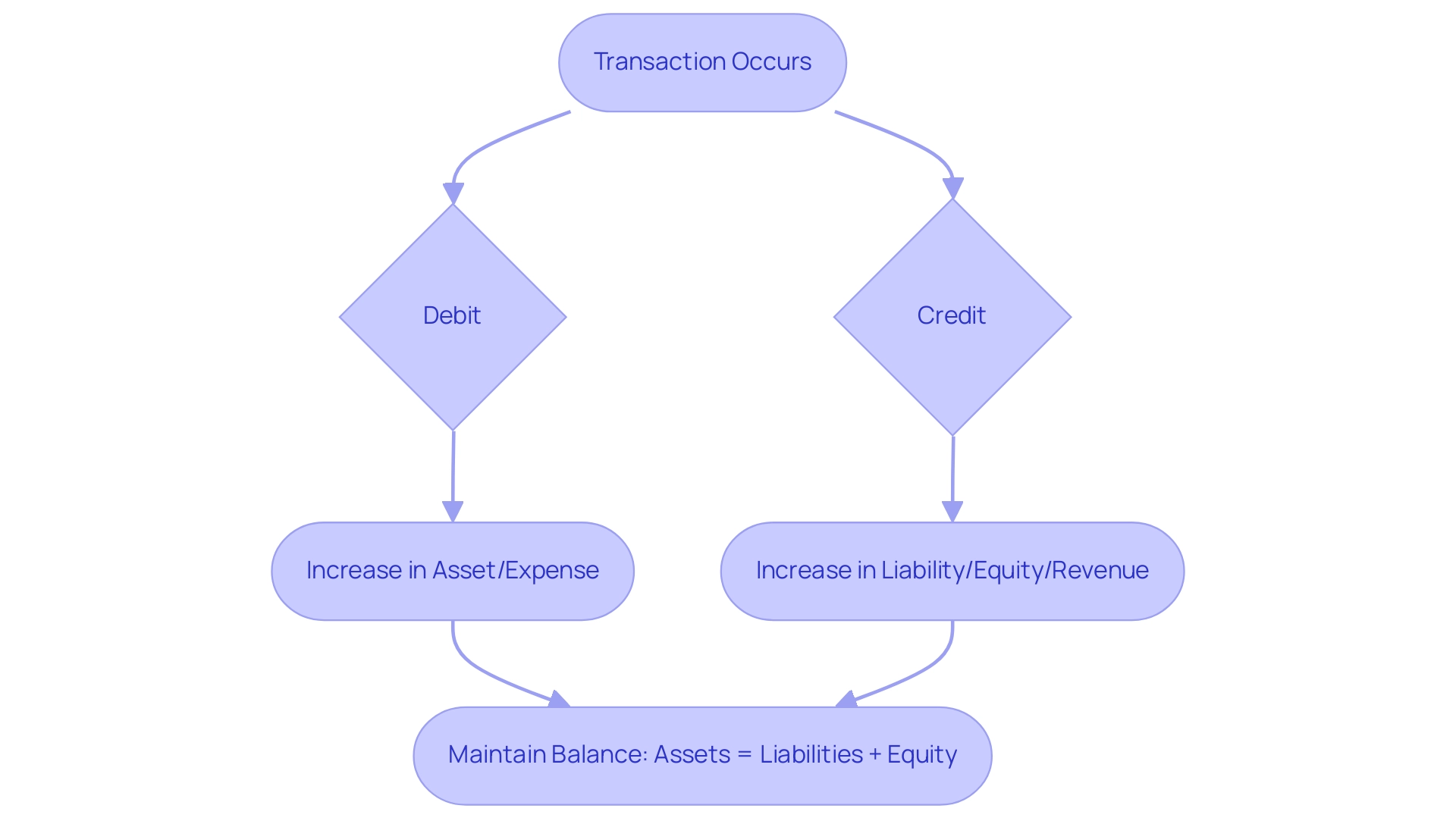
Understanding the Rules of Debit and Credit
Understanding the rules of debit credit accounting is essential for maintaining precise record keeping. These foundational principles can be summarized as follows:
- Assets increase with debits and decrease with credits.
- Liabilities increase with credits and decrease with debits.
- Equity accounts increase with credits and decrease with debits.
- Revenue accounts increase with credits and decrease with debits.
- Expenses increase with debits and decrease with credits.
This framework not only assists in recording transactions accurately but also plays a significant role in preventing common financial mistakes. Statistics indicate that a substantial percentage of freelancers struggle with understanding these rules, which can lead to inaccuracies in their financial records. In fact, businesses utilizing cloud financial systems, such as QuickBooks, which is the leading player in the small business finance market, have been shown to attract five times more customers than those that do not.
Expert opinions underscore the importance of mastering these rules. For instance, Mallory Barg Bulman, senior director of research in the Gartner Finance practice, states, "Given the potential of technology acceptance to reduce error rates in financial reporting, controllers should make sure they understand the levels of acceptance in their functions and improve it where necessary." This highlights that a solid grasp of debit credit accounting can significantly lower error rates in accounting.
By adhering to these principles, freelancers and small enterprise owners can streamline their bookkeeping processes, including debit credit accounting, ultimately allowing them to focus on growing their ventures rather than getting bogged down in administrative tasks.
The automated expense management platform exemplifies this transformation. Users like Emily J., a tax consultant, have noted that the company has drastically reduced the time spent on administrative tasks, allowing them to add more value to their clients' businesses. Similarly, Thomas H. shared that matching invoices with transactions, which used to take hours, is now automated and accurate, saving both him and his clients significant time.
The platform also enables users to effortlessly request absent invoices and consolidate their expenses and subscriptions, further improving their management experience. Case studies reveal that implementing accounts payable automation software, like this system, can save users an average of one hour per day. This efficiency improvement is directly linked to the proper understanding and application of these rules, as it enhances productivity and ensures that records remain precise and current, which is essential for effective business management.
With features like automated invoice collection, reconciliation, and affordable pricing starting at €0.15 per invoice after the first 50, Kulud empowers freelancers to manage their finances effortlessly, making it the ultimate solution for streamlined tax preparation and financial reporting.
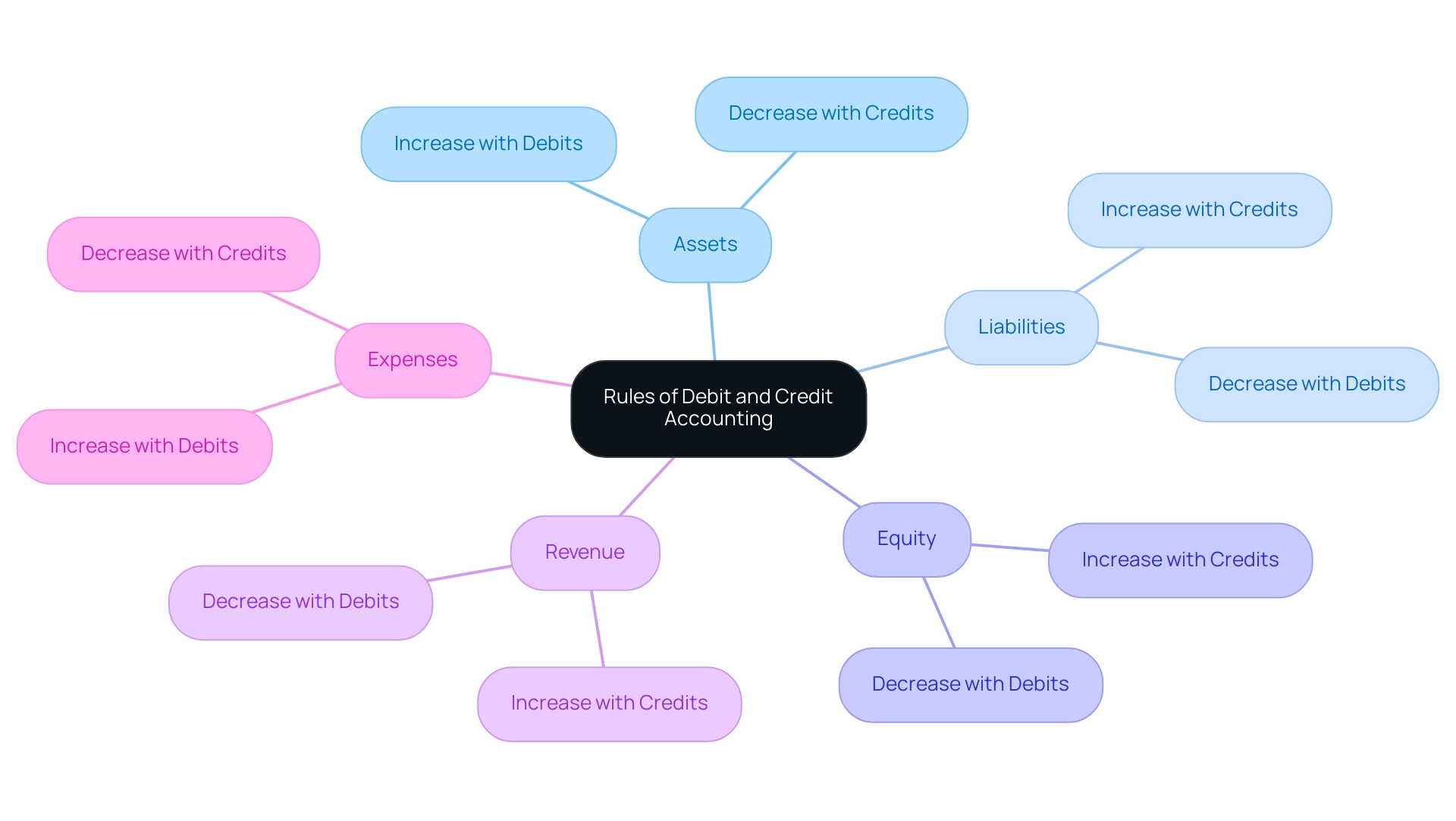
Real-World Examples of Debits and Credits
Consider the following examples that illustrate the application of debits and credits in the context of freelance accounting, enhanced by the capabilities of Kulud:
-
Purchasing Office Supplies: When a freelancer purchases $200 worth of office supplies, they would record this transaction by debiting the Office Supplies Expense account for $200. Simultaneously, they would credit the Cash account for $200, reflecting the outflow of cash. This transaction not only tracks the expense but also ensures that the debit credit accounting equation remains balanced. With this platform, freelancers can automate the collection of invoices for such purchases, significantly reducing the time spent on manual sorting and data entry. The automated categorization feature further simplifies this process by organizing expenses into relevant categories, making it easier to track spending.
-
Receiving Payment from a Client: Upon receiving $500 for services rendered, the freelancer would debit the Cash account for $500, indicating an increase in cash. Concurrently, they would credit the Revenue account for $500, which recognizes the income earned from the service provided. This dual entry highlights how income recognition impacts both cash flow and revenue reporting. The system further streamlines this process by automatically aligning bank transactions with documented income, ensuring precise oversight. Furthermore, Kulud can review past emails for receipts, enabling freelancers to retroactively collect crucial monetary information.
These examples underscore the fundamental principle of debit credit accounting, which is based on double-entry accounting, where each transaction affects at least two accounts, ensuring that the accounting equation (Assets = Liabilities + Equity) remains in equilibrium.
In 2025, freelancers are expected to spend significantly on office supplies and services, with estimates indicating that the average freelancer allocates around 30% of their income to these expenses. This statistic highlights the significance of accurately documenting these transactions to maintain a clear economic picture. Notably, total credits in the freelance sector amount to $21,350, illustrating the scale of transactions freelancers might encounter.
A practical case study involves a graphic designer who completes a project for $5,000. Upon receiving payment, the accountant records the income, which increases both the checking account and the income account. This example illustrates the relationship between income recognition and its impact on both the checking account and the owner's equity, emphasizing the need for debit credit accounting to account for business expenses before determining net income.
This case study aligns with the concept of income recognition, highlighting its importance in resource management.
Freelancers often share insights about managing their finances. For example, many indicate that comprehending debit credit accounting has simplified their record-keeping processes, allowing them to focus more on their creative work instead of getting overwhelmed by monetary details. As Georgi Knyazhev pointed out, 'This system has revolutionized my financial processes, enabling me to save time and enhance communication with my accountants.'
This sentiment reflects a broader trend among small business owners who recognize the importance of mastering these essential financial concepts to improve their financial management, further supported by automated features that facilitate effortless invoice collection and reconciliation.
Regarding pricing, the company offers a trial for processing 20 invoices and receipts, with a Pro plan allowing for 50 invoices per month at €0.15 per invoice starting from the 51st. This pricing structure makes Kulud an affordable choice for freelancers seeking to enhance their financial processes.
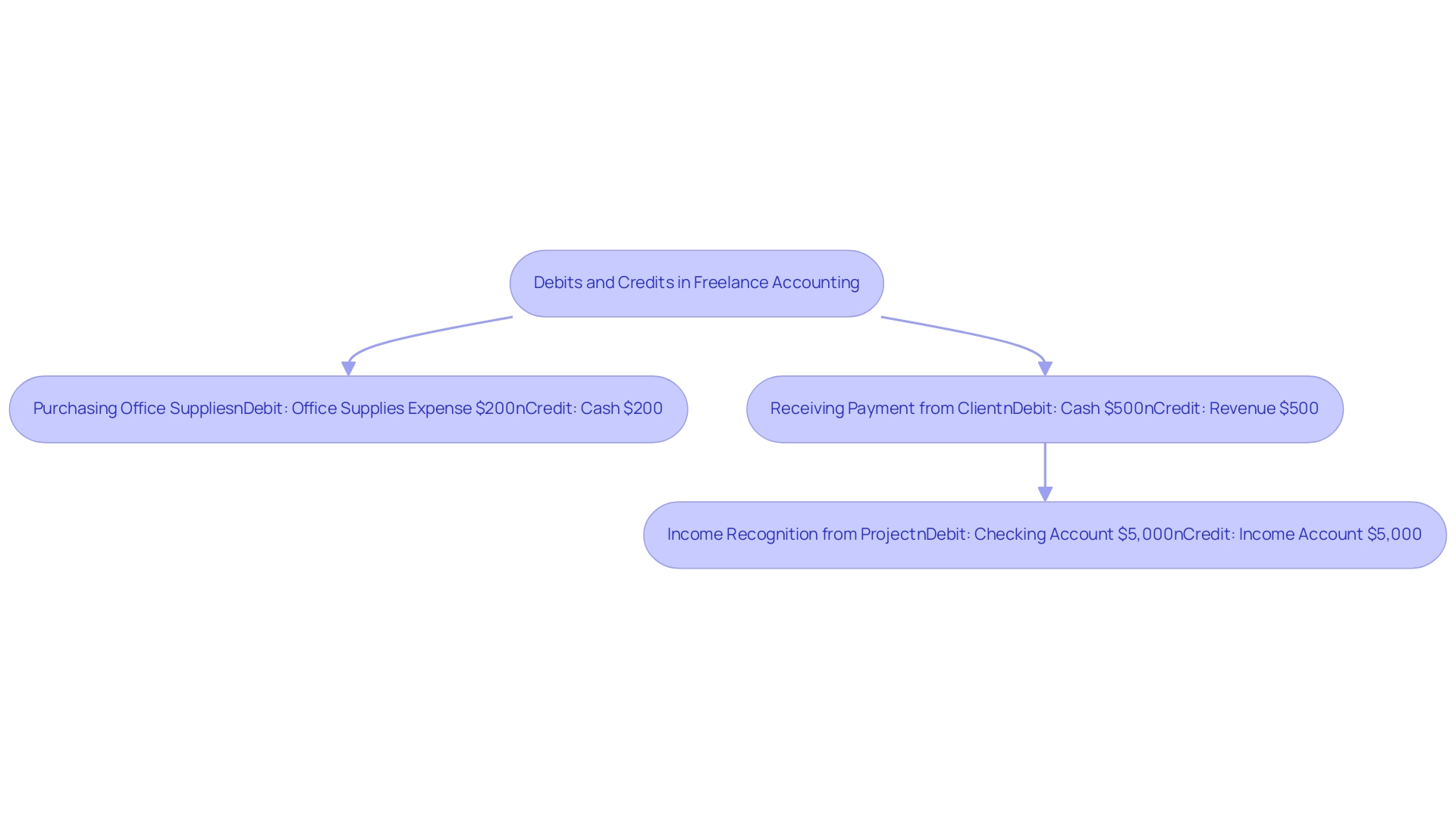
Common Mistakes to Avoid with Debits and Credits
Frequent errors in accounting can significantly impact monetary precision and organizational growth. Freelancers often face common concerns regarding expense management. Here are some prevalent errors to watch out for:
-
Misclassifying Accounts: One of the most frequent pitfalls is confusing asset accounts with expense accounts. This misclassification can lead to incorrect entries, affecting the overall financial picture. Mixing personal and business finances can exacerbate this issue, leading to significant complications as a business scales.
-
Failing to Balance: Ensuring that total debits equal total credits is fundamental in debit credit accounting practices. Neglecting these principles can result in unbalanced books, complicating monetary reporting and analysis. Incorrect Amounts: Entering the wrong amounts is another common mistake that can distort monetary reports. Even minor discrepancies can lead to significant issues over time, particularly for freelancers who need precise records for tax purposes.
-
Neglecting to Record Transactions: Failing to document all transactions can create incomplete statements, leading to misinformed business decisions. This oversight is particularly critical for freelancers, as accurate records are essential for maintaining financial health.
To mitigate these errors, it is crucial to adopt a vigilant approach. Regularly double-checking entries and utilizing automated tools can help ensure accuracy. The platform transforms expense management for freelancers and small enterprises through automation, enabling effortless invoice collection, categorization, and bank reconciliation. Its automated invoice matching feature ensures that invoices are seamlessly matched with bank transactions, reducing the risk of misclassification and incorrect amounts. Furthermore, the system automates categorization, making it easier for users to manage their finances effectively.
Statistics indicate that a significant percentage of freelancers struggle to balance their books, highlighting the need for effective bookkeeping practices. Did you know that telecommuting can boost productivity by 13%? Efficient bookkeeping methods, supported by various tools, can further improve this productivity. Additionally, cloud-based financial systems can greatly assist freelancers. Ana Djurovic noted that companies employing these systems attract five times the number of clients compared to conventional firms.
The organization has successfully completed a Cloud Application Security Assessment (CASA) and has been validated by the App Defense Alliance (ADA), ensuring a high level of security for users. By applying these strategies and adopting digital tools like Kulud, freelancers can improve their money management and steer clear of the traps linked to typical bookkeeping errors. Furthermore, users can effortlessly export reports in PDF format, streamlining their fiscal and tracking processes. We invite you to try the platform and experience the benefits for yourself.
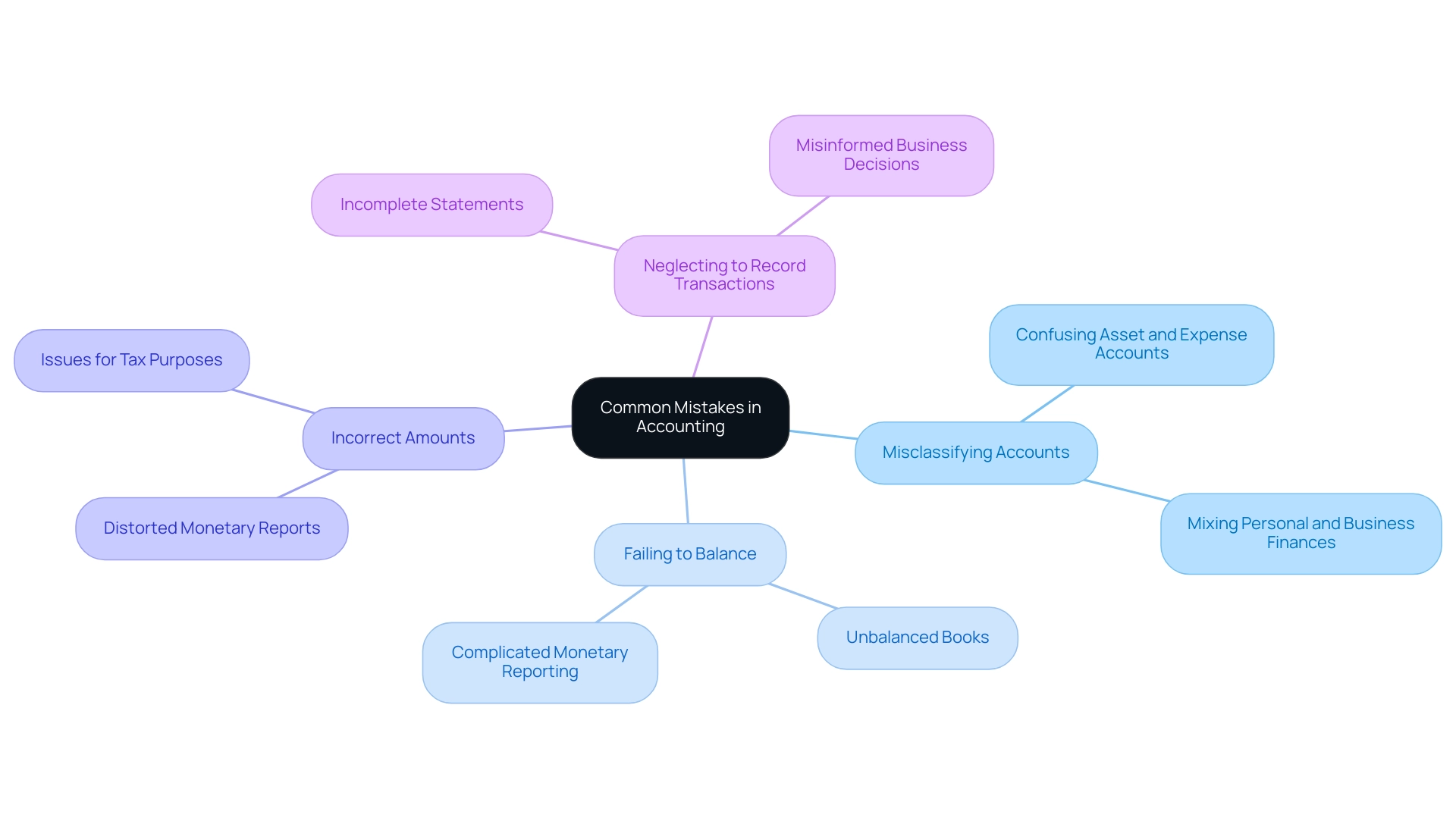
The Role of Debits and Credits in Financial Accuracy
Debits and credits are essential elements of debit credit accounting, playing a crucial role in ensuring monetary accuracy. They act as the backbone for monitoring the inflow and outflow of funds within an enterprise, aiding in the preparation of accurate fiscal statements, including the balance sheet and income statement. When documented precisely, debits and credits provide a clear perspective of a company's economic health, which is essential for informed decision-making and strategic planning.
The significance of maintaining accurate records cannot be overstated. In 2025, the focus on monetary precision is more essential than ever, as companies encounter growing examination from stakeholders. Precise monetary reporting not only boosts trust and credibility but also aids effective organizational decision-making.
For example, information from the Small Enterprise Administration suggests that small enterprises with accurate fiscal records are more likely to obtain funding and draw in investors.
Regularly reviewing accounts and reconciling discrepancies is vital for sustaining this accuracy. Financial analysts emphasize that the consistent application of debit credit accounting can significantly enhance a company's operational efficiency. This means that, in the construction sector, where project complexity and fluctuating material costs contribute to a 25% failure rate among new businesses within the first year, accurate accounting practices can be the difference between success and failure.
In contrast, the healthcare and social assistance industries demonstrate resilience with the highest survival rates, largely due to their consistent demand for services and the importance of accurate financial management.
Emily J., a tax consultant, shares, "Kulud has transformed how I work with clients. I spend less time on admin tasks and more time enhancing their operations, which highlights the practical benefits of leveraging debit credit accounting effectively, enabling businesses to navigate challenges and capitalize on opportunities, ultimately leading to improved financial outcomes." Additionally, Thomas H. notes, "Matching invoices with transactions used to take hours. With this system, it's automated and precise, saving me and my clients so much time."
The platform provides features such as the ability to connect your bank account, which allows for seamless matching of invoices with transactions. Users can process up to 20 invoices and receipts for free, with additional processing available at €0.15 per invoice starting from the 51st. The platform also supports unlimited exports in CSV, PDF, and ZIP formats, making it easier for freelancers and small enterprise owners to manage their records efficiently.
Moreover, the organization emphasizes security, having passed rigorous assessments to ensure user data confidentiality and protection. By centralizing financial information and automating tedious tasks like invoice processing and bank transaction matching, Kulud empowers freelancers and small enterprise owners to concentrate on scaling their operations while maintaining accurate financial records.
In summary, the meticulous application of debit credit accounting is not just a technical requirement; it serves as a strategic advantage that enables organizations to thrive in a competitive landscape.

Leveraging Technology for Effective Debit and Credit Management
Technology is revolutionizing debit credit accounting management, enhancing efficiency and accuracy like never before. Many freelancers and small business owners often express concerns about managing their expenses effectively. Modern accounting software automates the recording of transactions, ensuring that debit credit accounting is performed consistently and without error. Platforms like Kulud stand out by automating invoice processing and reconciling transactions with bank accounts, addressing these common worries.
With Kulud, users can connect their bank accounts, allowing the platform to match invoices with transactions seamlessly. This automation significantly reduces the time spent on bookkeeping—transforming hours of manual work into mere minutes—and minimizes the risk of mistakes that can lead to monetary discrepancies. Furthermore, users can effortlessly transfer their information to financial software or share it with their financial advisors, enhancing their monetary management processes.
Current trends indicate that 60% of small enterprise owners feel unknowledgeable about finances, and a staggering 70% do not employ a financial advisor. This gap emphasizes the need for accessible financial solutions that enable individuals to manage their finances effectively. By leveraging technology, freelancers can streamline their financial processes, allowing them to concentrate on business growth rather than administrative burdens.
As noted, 47% of CIOs believe that the COVID-19 pandemic has accelerated digital transformation and increased the use of new technologies like AI, machine learning, blockchain, and automation. This shift highlights the significance of embracing advanced financial solutions that simplify tax preparation by automating invoice collection and reconciliation for effortless management of finances. Kulud also features automated categorization of receipts and can extract information from emails, saving users valuable time.
Real-world examples illustrate the impact of financial software on debit credit accounting and management. Agile financial practices, which incorporate responsive methodologies into financial software, are becoming increasingly popular. These practices enhance productivity and improve communication among stakeholders, showcasing how technology can adapt to meet the evolving needs of businesses.
Moreover, expert opinions emphasize the transformative role of automation in financial management. Developers of financial software frequently note that automation not only enhances accuracy but also provides significant time savings, enabling users to focus on strategic initiatives rather than getting bogged down in routine tasks. As the market for financial advisory and consulting is projected to grow by $21 billion, the integration of advanced technologies like AI and machine learning into accounting practices is set to become a defining trend in 2025 and beyond.
Furthermore, Kulud has successfully completed a Cloud Application Security Assessment (CASA), ensuring a high level of security for its users. With these advancements, we encourage you to explore the benefits of Kulud and see how it can transform your financial management experience.
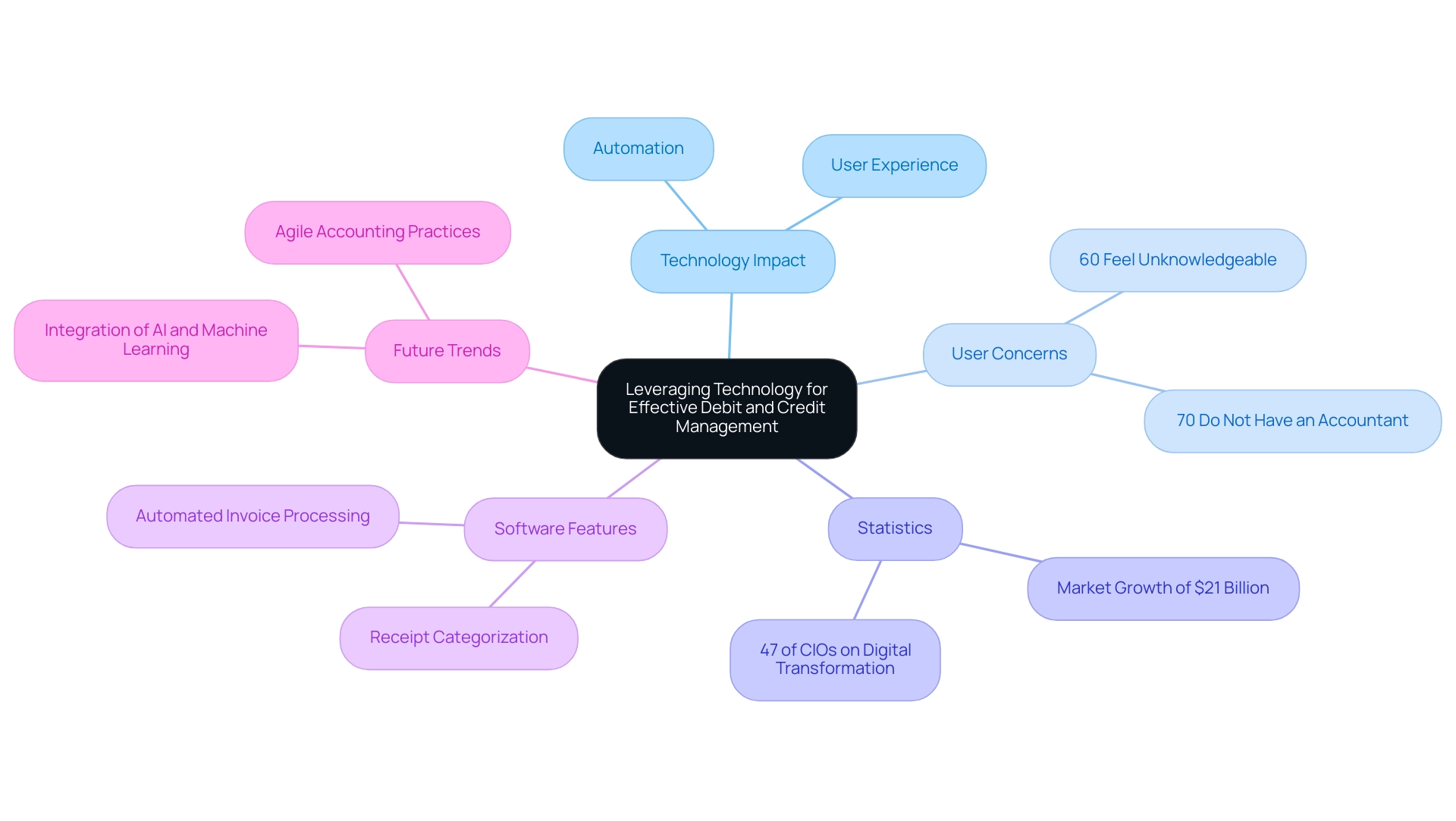
Conclusion
The principles of debits and credits form the backbone of effective accounting, essential for freelancers and small business owners striving for financial accuracy and integrity. By mastering these foundational concepts, individuals can ensure that every transaction is recorded systematically, maintaining the balance of the accounting equation:
- Assets = Liabilities + Equity.
Furthermore, the integration of technology, particularly through platforms like Kulud, enhances this process by automating routine tasks such as invoice processing and bank reconciliation. This allows users to focus on strategic business growth rather than administrative burdens.
Understanding the rules governing debits and credits is crucial in preventing common accounting mistakes that can skew financial reports. By adhering to these principles and leveraging advanced tools, freelancers can streamline their bookkeeping processes, reduce error rates, and maintain accurate records that are vital for informed decision-making. In addition to this, as the demand for precise financial management grows in a rapidly evolving landscape, the ability to navigate the complexities of accounting becomes increasingly important.
In conclusion, the meticulous application of debits and credits, supported by innovative technology, not only enhances operational efficiency but also empowers businesses to thrive in a competitive environment. The shift towards automation in accounting signifies a transformative era, enabling freelancers and small business owners to manage their finances effortlessly while ensuring compliance and accuracy. As the accounting landscape continues to evolve, embracing these principles and tools will be key to achieving lasting financial success.
Frequently Asked Questions
What are debits and credits in accounting?
In accounting, debits (denoted as 'Dr') signify an increase in asset or expense accounts, while credits (marked as 'Cr') indicate an increase in liability, equity, or revenue accounts. They are foundational components of the double-entry system, ensuring balance in financial reporting.
How does the double-entry system work?
The double-entry system requires that every monetary transaction affects at least two accounts, maintaining the equation: Assets = Liabilities + Equity. For example, when a company acquires inventory, it debits the inventory account (increasing assets) and credits the cash or accounts payable account (decreasing cash or increasing liabilities).
What percentage of businesses use the double-entry bookkeeping system?
Approximately 70% of businesses utilize the double-entry bookkeeping system, highlighting its reliability in contemporary record-keeping practices.
How does technology impact accounting practices?
The adoption of robotic process automation has been shown to enhance efficiency by 44%. This integration of technology helps freelancers streamline expense management, such as aligning invoices with bank transactions and automating categorization.
Why is understanding debit credit accounting important for freelancers?
Understanding debit credit accounting is vital for managing finances accurately and adhering to regulatory standards. It helps prevent common financial mistakes and enhances the ability to monitor transactions effectively.
What are the basic rules of debit credit accounting?
The foundational principles are: 1. Assets increase with debits and decrease with credits. 2. Liabilities increase with credits and decrease with debits. 3. Equity accounts increase with credits and decrease with debits. 4. Revenue accounts increase with credits and decrease with debits. 5. Expenses increase with debits and decrease with credits.
How can mastering debit credit accounting reduce errors?
A solid grasp of these rules can significantly lower error rates in financial reporting, as highlighted by experts in the field. Understanding the principles helps in recording transactions accurately and prevents inaccuracies in financial records.
What benefits do automated platforms provide for freelancers?
Automated expense management platforms can save significant time on administrative tasks, such as matching invoices with transactions. Users report improvements in efficiency, allowing them to focus on adding value to their clients' businesses.
What features does the Kulud platform offer for managing finances?
Kulud provides features like automated invoice collection, reconciliation, and affordable pricing, starting at €0.15 per invoice after the first 50. It helps freelancers streamline tax preparation and financial reporting.
What is the median annual wage for accountants and auditors?
The median annual wage for accountants and auditors is $71,550, making understanding debit credit accounting valuable for freelancers aiming to manage their finances effectively.



